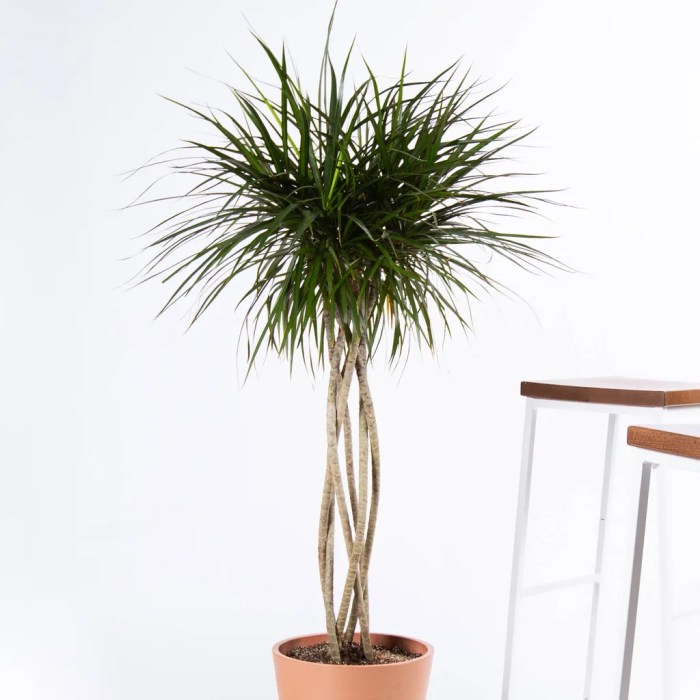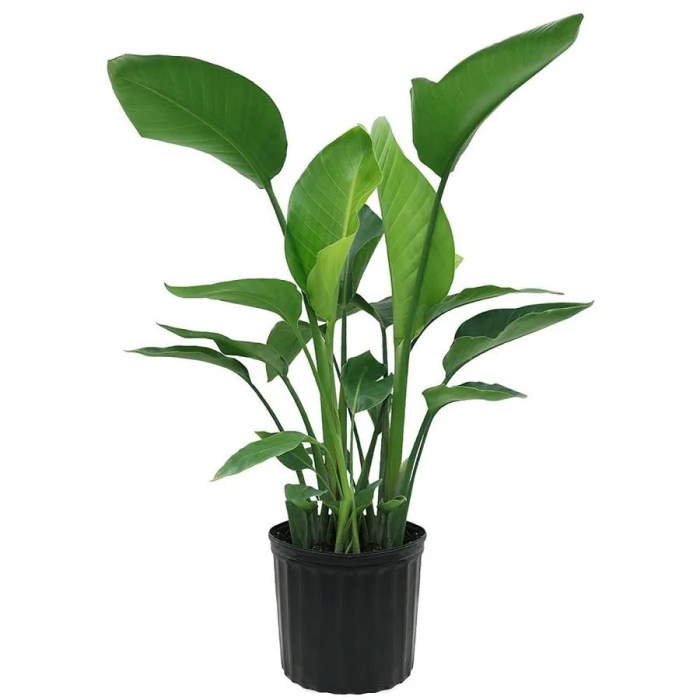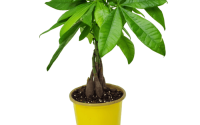Tropical Tree Plant Indoor A Growing Guide
Propagation Methods

Tropical tree plant indoor – So, you’ve got your gorgeous tropical indoor tree and you’re ready to expand your little jungle? That’s the Pontianak spirit! Multiplying your leafy friends is easier than you think, especially with the right techniques. We’ll explore three common methods: cuttings, seeds, and air layering. Each has its own quirks, so let’s dive in!
Cuttings Propagation
This method involves taking a piece of a stem and encouraging it to root and grow into a new plant. It’s a popular choice for many tropical indoor trees because it’s relatively quick and often successful. The key is to select a healthy, non-flowering stem cutting, ideally about 4-6 inches long.
- Prepare the Cutting: Use a sharp, clean knife or pruning shears to make a clean cut just below a node (the point where leaves or branches grow from the stem). Remove the lower leaves to prevent rotting.
- Treat with Rooting Hormone (Optional): Dipping the cut end in rooting hormone powder can significantly increase the chances of success. This powder contains plant hormones that stimulate root growth.
- Planting the Cutting: Plant the cutting in a well-draining potting mix, burying about 2 inches of the stem. Ensure the soil is moist but not soggy.
- Provide Humidity and Light: Cover the cutting with a plastic bag or humidity dome to create a humid environment. Place it in a location with bright, indirect light.
- Maintain Moisture: Regularly check the moisture level of the soil and water as needed, keeping it consistently moist but not waterlogged. Roots should start to develop within a few weeks to a couple of months.
Seed Propagation
Growing tropical trees from seeds can be a rewarding but more time-consuming process. Germination rates can vary depending on the species and the age of the seeds. Fresh seeds generally have a higher success rate.
Successfully cultivating tropical tree plants indoors often begins with propagation from seedlings. Understanding the fundamental techniques involved in establishing these young plants is crucial for their long-term health and growth; for detailed guidance, consult this comprehensive guide on how to plant seedling trees. Proper seedling care ensures your indoor tropical tree thrives and brings the vibrancy of the tropics into your home.
- Seed Preparation: Some seeds may require pre-treatment, such as scarification (slightly damaging the seed coat) or stratification (simulating cold winter conditions). Check the specific requirements for your tree species.
- Sowing the Seeds: Sow the seeds in a well-draining seed-starting mix, covering them with a thin layer of soil. The depth depends on the seed size; generally, it’s about twice the seed’s diameter.
- Provide Warmth and Moisture: Maintain a consistently warm and moist environment. You can use a heat mat to boost germination. A humidity dome can also help maintain humidity.
- Light Requirements: Provide bright, indirect light. Avoid direct sunlight, which can scorch the delicate seedlings.
- Transplanting: Once the seedlings have developed a few true leaves, they can be transplanted into individual pots.
Air Layering Propagation, Tropical tree plant indoor
Air layering is a technique used to root a stem while it’s still attached to the parent plant. This is particularly useful for larger stems that are difficult to root as cuttings. It’s a bit more involved but yields a mature plant relatively quickly.
- Select a Stem: Choose a healthy, mature stem about 1/2 inch to 1 inch in diameter. Make a ring of bark about 1-2 inches wide around the stem.
- Apply Rooting Hormone: Apply rooting hormone powder to the exposed area of the stem.
- Wrap with Moist Sphagnum Moss: Wrap the exposed area with moist sphagnum moss, keeping it damp. Cover the moss with plastic wrap to retain moisture and secure it with twine or tape.
- Monitor and Water: Keep the moss consistently moist. Roots will typically develop within several weeks to a few months.
- Sever and Pot: Once roots have developed, carefully cut the stem below the rooted section and plant it in a pot.
Aesthetic Considerations and Design: Tropical Tree Plant Indoor

Bringing the lush vibes of the tropics indoors ain’t just about having plants; it’s about crafting a look that screams “holiday getaway, everyday!” Think beyond just plopping a plant in a corner – we’re talking about integrating these green beauties into your home’s overall aesthetic. It’s all about finding that perfect balance between nature’s raw beauty and your personal style.Incorporating tropical indoor trees into your home design is like adding a splash of vibrant color to a neutral canvas.
The size, shape, and even the pot of your tree can dramatically change the feel of a room. A towering palm can create a dramatic focal point, while a smaller, bushier plant can add a touch of softness to a shelf. Let’s explore how to make these leafy friends truly shine in your space.
Tropical Trees in Various Interior Design Styles
Tropical trees are incredibly versatile and can easily complement a wide range of interior design styles. For example, a minimalist space could be beautifully enhanced by a single, elegantly shaped ficus, its clean lines echoing the simplicity of the décor. In contrast, a bohemian-style room could be infused with even more vibrancy by incorporating a collection of diverse tropical plants, each adding its own unique texture and color.
A mid-century modern setting might welcome a fiddle-leaf fig, its sculptural form complementing the clean lines of the furniture. Think about the overall mood you want to create and select plants that harmonize with that vision.
Visual Impact of Tree Sizes and Shapes
The size and shape of your tropical tree significantly influence the room’s visual dynamics. A large, statement tree, like a majestic Kentia palm, can instantly command attention and become a striking focal point, especially in a spacious living room or even a sun-drenched hallway. Smaller trees, such as a compact bird of paradise, can add subtle pops of green to shelves, side tables, or even window sills, creating a more intimate and cozy atmosphere.
Consider the scale of your room and choose tree sizes that are proportionate to the space. A tiny tree in a vast room might get lost, while an oversized tree in a small room could feel overwhelming.
Using Tropical Trees as Focal Points or Complementary Décor
Imagine this: a large, healthy Areca palm standing proudly in the corner of your living room, its fronds reaching towards the ceiling. This immediately draws the eye and becomes the undeniable centerpiece of the room. This is a perfect example of using a tropical tree as a focal point. Alternatively, you can use smaller trees to complement existing décor. For instance, several smaller plants placed strategically around a fireplace can soften the room’s hard lines and create a warm, inviting ambiance.
Creating Visually Appealing Displays with Multiple Tropical Trees
Creating a captivating indoor jungle is all about careful arrangement and variety.
- Varying Heights and Sizes: Combine tall, slender trees with shorter, bushier ones to create visual interest and depth. Imagine a tall bamboo plant standing sentinel behind a collection of smaller ferns and bromeliads.
- Playing with Textures and Colors: Incorporate plants with different leaf shapes, textures, and colors to add complexity and visual richness. A bright-leaved croton could pop beautifully next to a plant with more muted tones.
- Grouping Plants Strategically: Instead of scattering plants haphazardly, group them together to create mini-ecosystems. This not only looks visually appealing but also helps to improve humidity levels around the plants.
- Using Different Potting Styles: Different pot styles and materials add another layer of visual appeal. Mix and match terracotta, ceramic, or woven baskets to create a dynamic display.
- Consider the Background: The backdrop against which you display your plants also matters. A plain wall will allow the plants to take center stage, while a patterned wall might require more careful consideration of plant placement and color schemes.
Expert Answers
What are the best low-light tropical indoor trees?
Snake plants, ZZ plants, and some varieties of Ficus are tolerant of low-light conditions.
How often should I repot my indoor tropical tree?
Repotting is generally needed every 1-2 years, or when roots become root-bound.
What are the signs of overwatering in an indoor tropical tree?
Yellowing leaves, soggy soil, and a foul odor are indicative of overwatering.
How can I increase humidity for my indoor tropical tree?
Use a humidifier, pebble tray, or group plants together to increase humidity.



